Eric Miller of Project Warbird and I have just returned from a trip to Windsor Locks, Connecticut, visiting the New England Air Museum. 19 hours on the road between South Carolina and Connecticut. The NEAM has been friends of ours for a long time and director Nick Hurley is soon to leave the museum, taking up a professorship at West Point. And since Eric had some Vultee BT-13 parts up there he was due to pick up, I tagged along so I could take up Nick’s offer to visit before leaving.
The NEAM is a fantastic operation, and their collection is second to none. The professionalism of the staff and the quality of their restorations make this air museum definitely worth a visit. If you have the chance to check them out, please do so.
Rather than go through the entirety of their collection, I thought I would share some pieces that were highlights for us.
First up is the Sikorsky VS-44 flying boat Excambian (NC 14881).
Aviation genius Igor Sikorsky immigrated to the United States in 1919 due to communist upheaval in Russia, finally settling in Connecticut in 1929. The inventor of the first four engine aircraft (1913), Sikorsky was (prior to inventing the helicopter) best known for designing Pan American Airways’ Clipper flying boats. When Sikorsky fell out of favor with troublesome CEO Juan Trippe, Pan Am moved on to using Martin, then Boeing, Clippers. While the Clipper flying boats from these three companies were all iconic, only the Sikorsky VS-44 remains today.
While VS-44 never actually flew for Pan Am, she was made as a competitor to the famous Boeing 314. Sikorsky made three VS-44s, all of which entered service during the war, flying with what is today American Airlines. While the other two VS-44s were lost in accidents, Exambian saw service until 1969, most famously under Charles Blair and actress Maureen O’Hara, carrying passengers to the Virgin Islands. Beached after hitting some rocks, for a time she was used as a hot dog stand, before finally being brought to the museum via barge in 1987. Her restoration took a full ten years, but the result is breathtaking. Photos do not do the airplane justice.
Next is the Boeing B-29A 44-61975, painted in the colors of Jack’s Hack (44-61566, 468BG).
Built too late to see combat in the Second World War, this SuperFort saw service in Great Britain during the Korean War. Damaged from a midair collision in 1953, she was used for target practice at Aberdeen Proving Grounds before being acquired by the museum in 1973. Nearly destroyed by the tornado which butchered the museum in 1979, this B-29 was carefully restored thanks to the backing of the 58th Bomb Wing Association. She now sits as the centerpiece of a display dedicated to the 58BW, her restoration being completed in 2006.
I first met Nick online three years ago, reaching out to him regarding the paper cup dispenser and chemical toilet about Jack’s Hack, as these are pieces which we still lack for Lucky Thirteen. Nick was gracious enough to invite me to come check out the interior of Jack’s Hack in person. Words cannot express how thankful I am for the opportunity to do so. It was something I will never forget – thanks man.
Next is the control car for the Goodyear blimp K-28.
Goodyear’s association with blimps is an interesting story, too long to go into extensive detail here. Suffice it to say, Zeppelin CEO Hugh Eckener was able to save the economic implosion of his company after the Great War by partnering with Goodyear Tire & Rubber of Akron, Ohio. While dirigibles are largely a thing of the past, the name Goodyear is today synonymous with blimps. Natural submarine chasers, no ship was ever lost under the protection of a blimp.
The museum’s K-series control car is one of only two in existence, and the complex restoration of this gondola has to be seen in person to be truly appreciated.
Lastly is a piece which we were unfamiliar with: the Burnelli CBY-3.
Designed by Vincent Burnelli of Canadian Car and Foundry of Montreal, this aircraft is the only one of its kind in existence. Burnelli was a pioneer in ‘lifting fuselage’ type aircraft and this test model was built in 1944 to promote the concept. While not a particularly attractive design, the interior is so roomy as to defy belief. It has no wing spars – something that gives us B-17 guys heart palpitations!
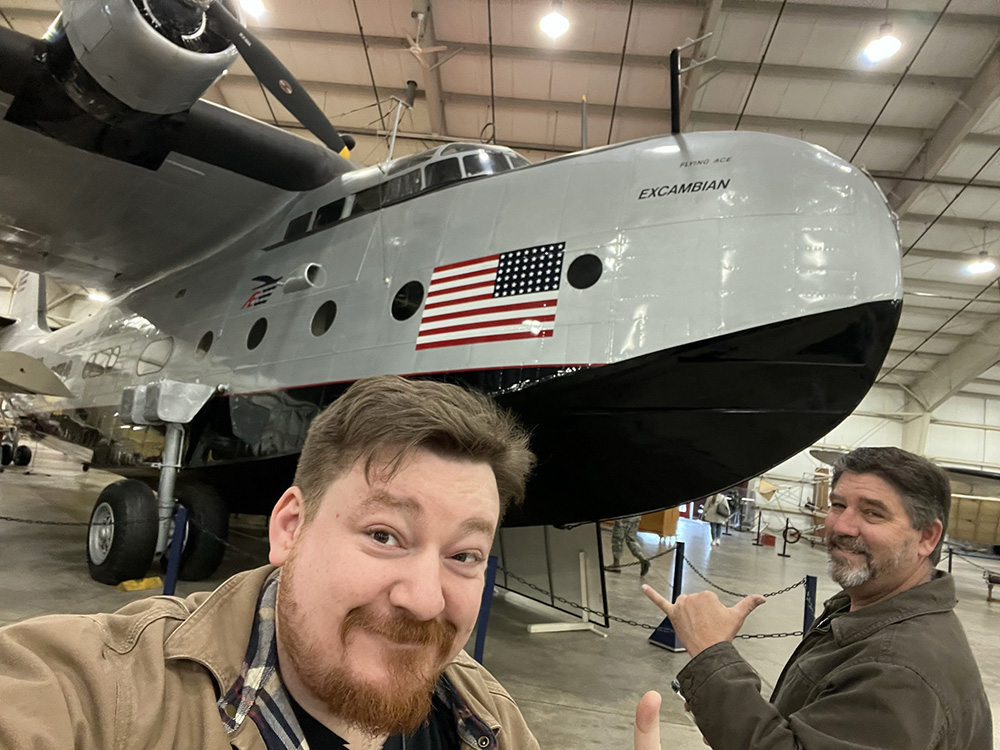
Eric and I in front of the Sikorsky VS-44 flying boat Excambian (NC 14881).
Photo taken 28 March 2023.
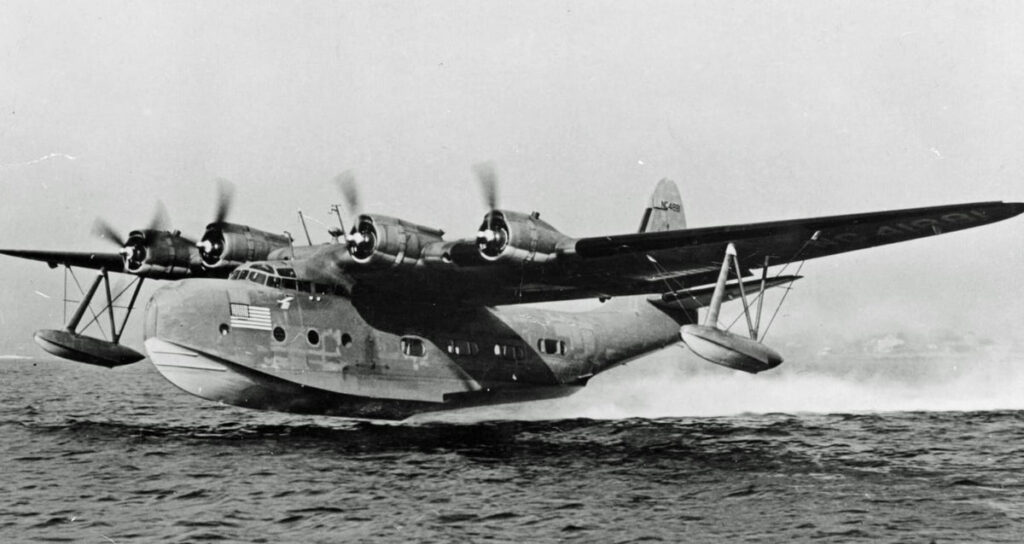
Excambian in military service as the JR2S-1, ferrying passengers and freight from New York to Foynes, Ireland.
This route was previously famous as the Boeing 314’s route for Pan Am. The drink “Irish Coffee” was invented by the Foyne terminal for passengers disembarking from these flights.

Excambian prior to her restoration.
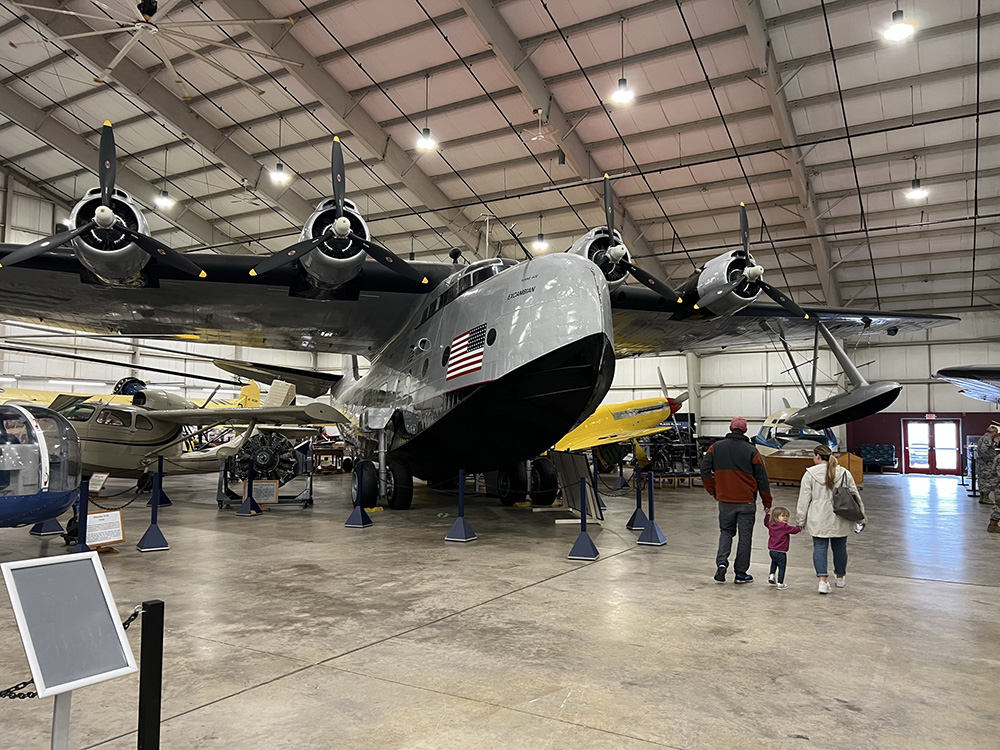
Excambian fully restored and on display at the New England Air Museum.
Photo taken 28 March 2023.

The interior of Excambian.
The seats here can be folded down to convert into beds.
Photo taken 28 March 2023.

Boeing B-29A 44-61975 on display at the New England Air Museum.
Photo taken 28 March 2023.

Looking back from the forward bomb bay of Boeing B-29A 44-61975.
The AN/APQ-13 radar has been removed from its radome (which sat between the two bays beneath the carry-thrus and oxygen tank bundle) so it can be displayed externally.
Photo taken 28 March 2023.
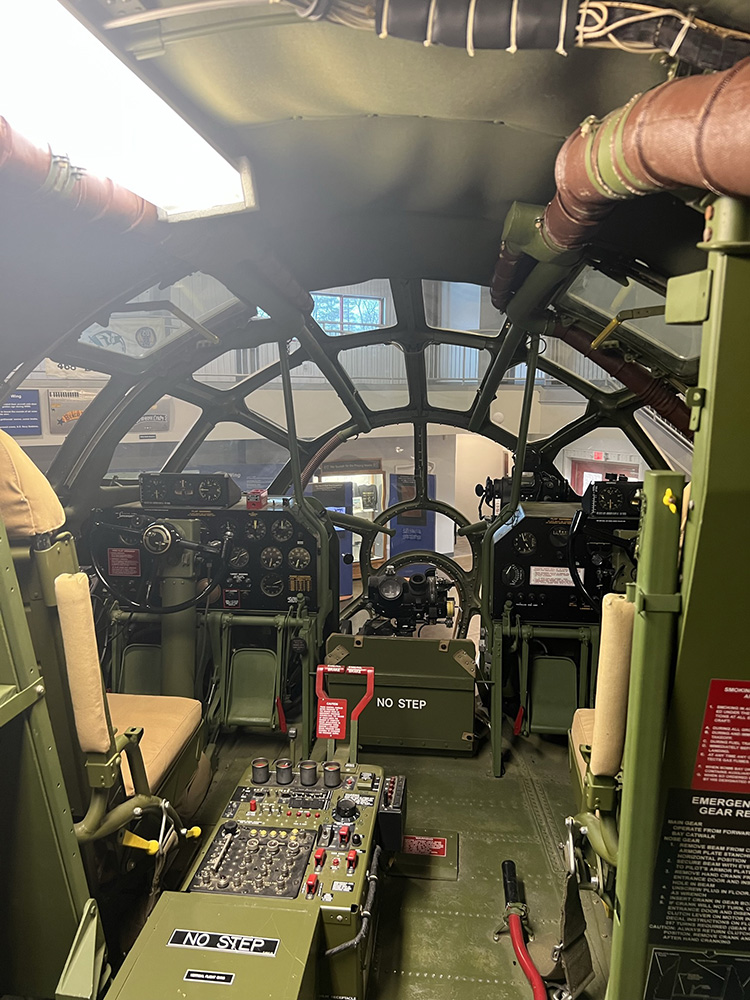
Looking forward into the cockpit of Boeing B-29A 44-61975.
Note the fabric and insulation. This is one of a tiny few restorations which have ever attempted to accurately replicate this facet of wartime US bombers.
Photo taken 28 March 2023.
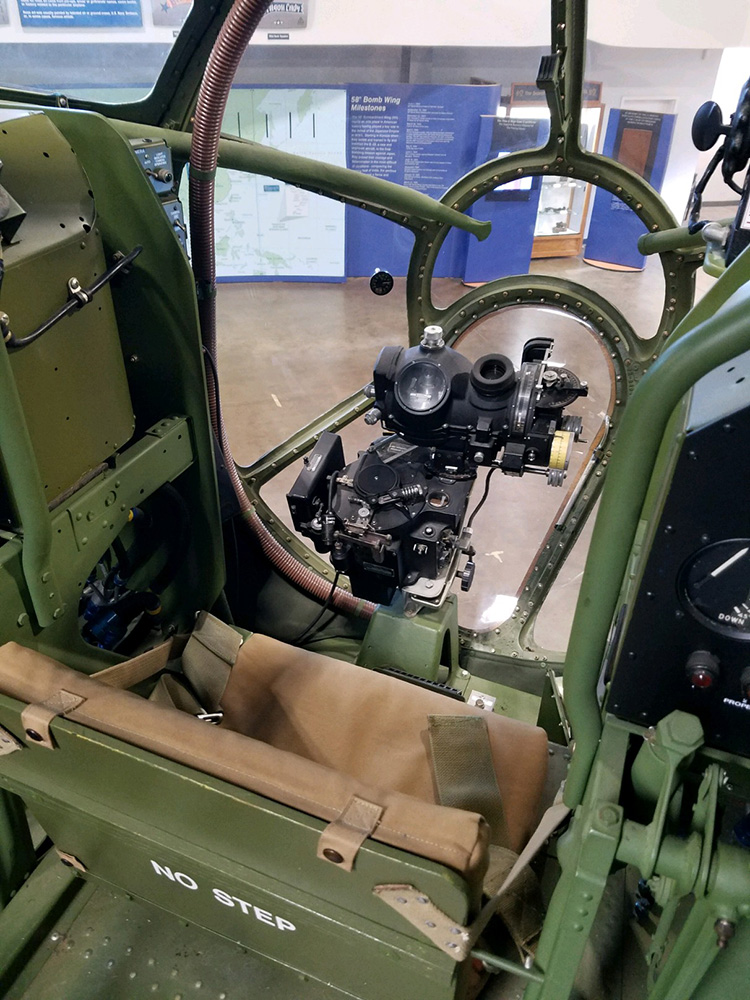
The bombardier’s position aboard Boeing B-29A 44-61975.
Photo taken 28 March 2023.
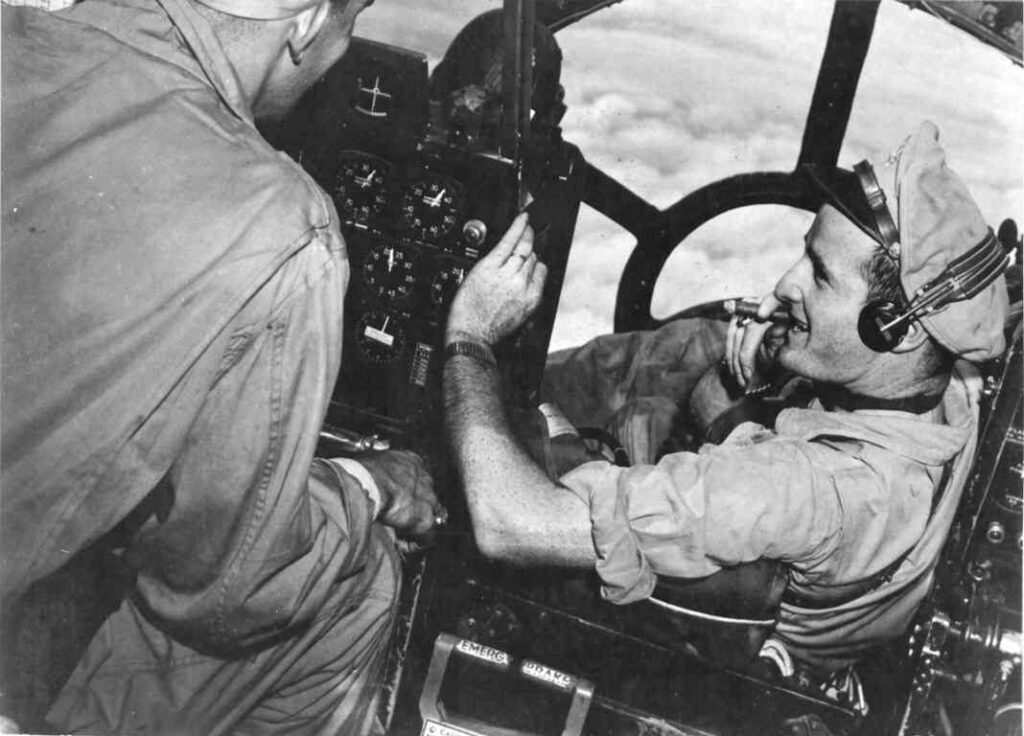
Bombardier 2LT William L. Gardner converses with pilot CPT Jack C. Ledford aboard 20th Century Unlimited (42-6281, 40BG).
The fact that the Boeing B-29 was pressurized allow the crew to work in far greater comfort than unpressurized aircraft like the Boeing B-17 and Consolidated B-24.
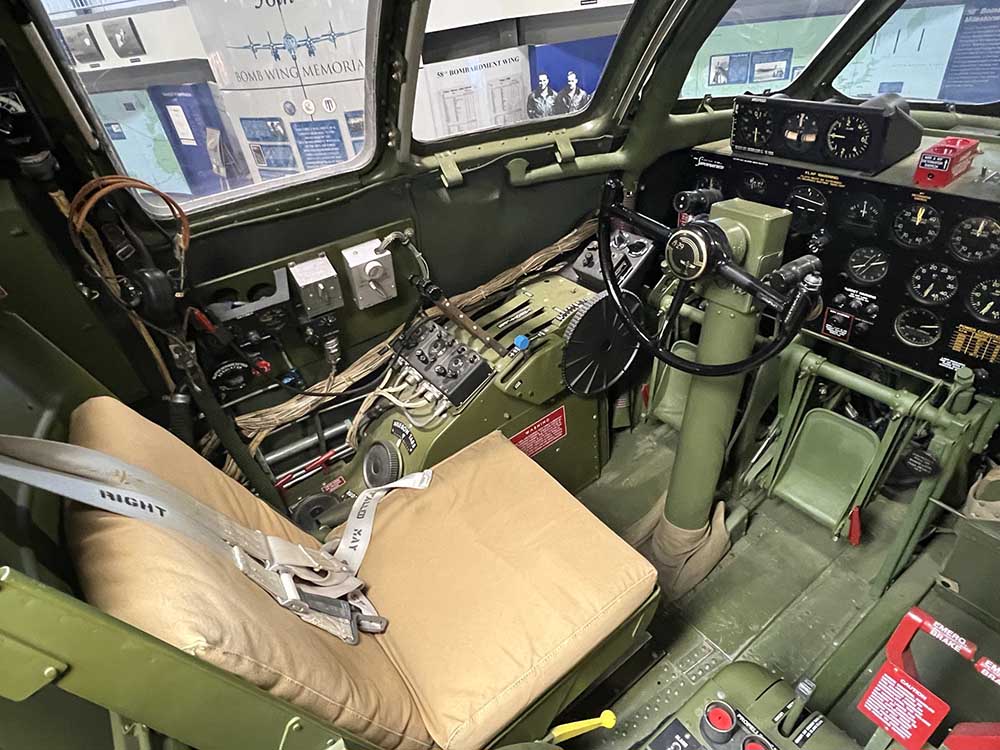
The pilot’s seat aboard Boeing B-29A 44-61975.
Virtually all of the components you see here are shared with the Boeing B-17.
Photo taken 28 March 2023.
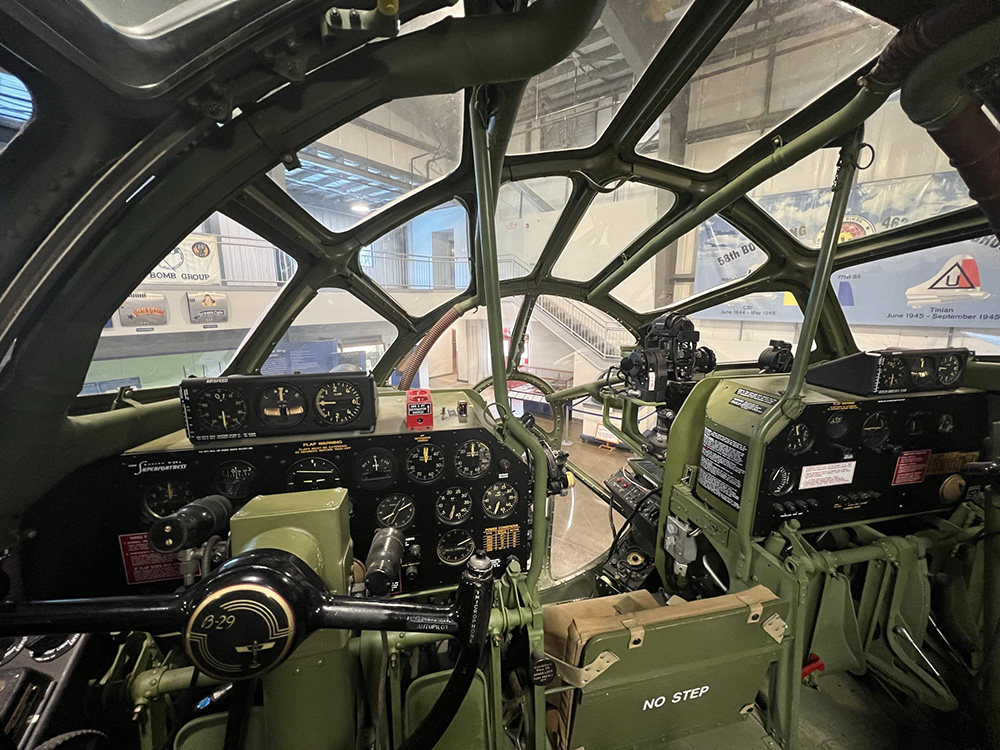
The view from the pilot’s seat aboard Boeing B-29A 44-61975.
While I always thought the B-29’s nose setup was awkward, sitting there changed my opinion completely. It was incredibly comfortable and well laid out.
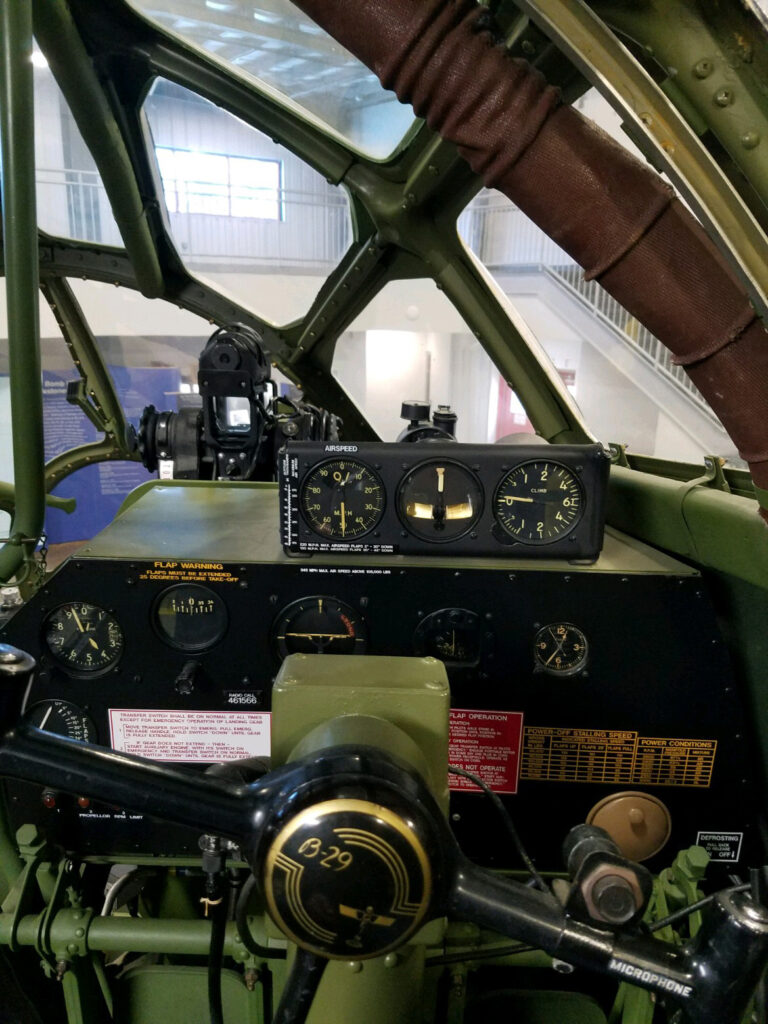
Eric’s view in the co-pilot seat of Boeing B-29A 44-61975.
Photo taken 28 March 2023.
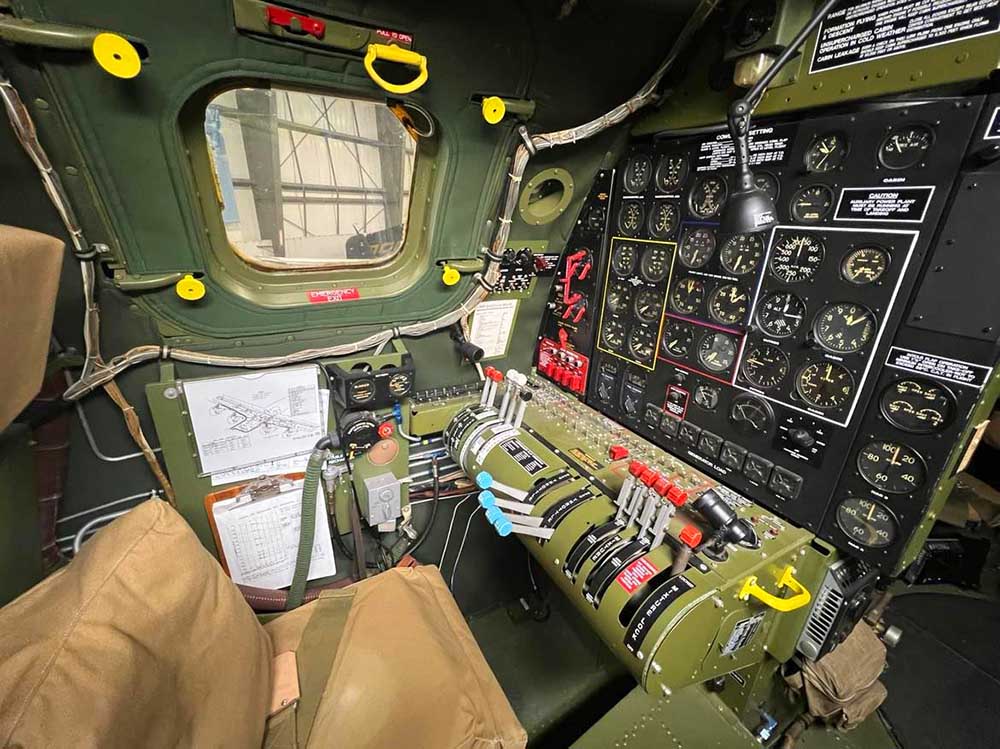
The flight engineer’s position aboard Boeing B-29A 44-61975.
Photo taken 28 March 2023.
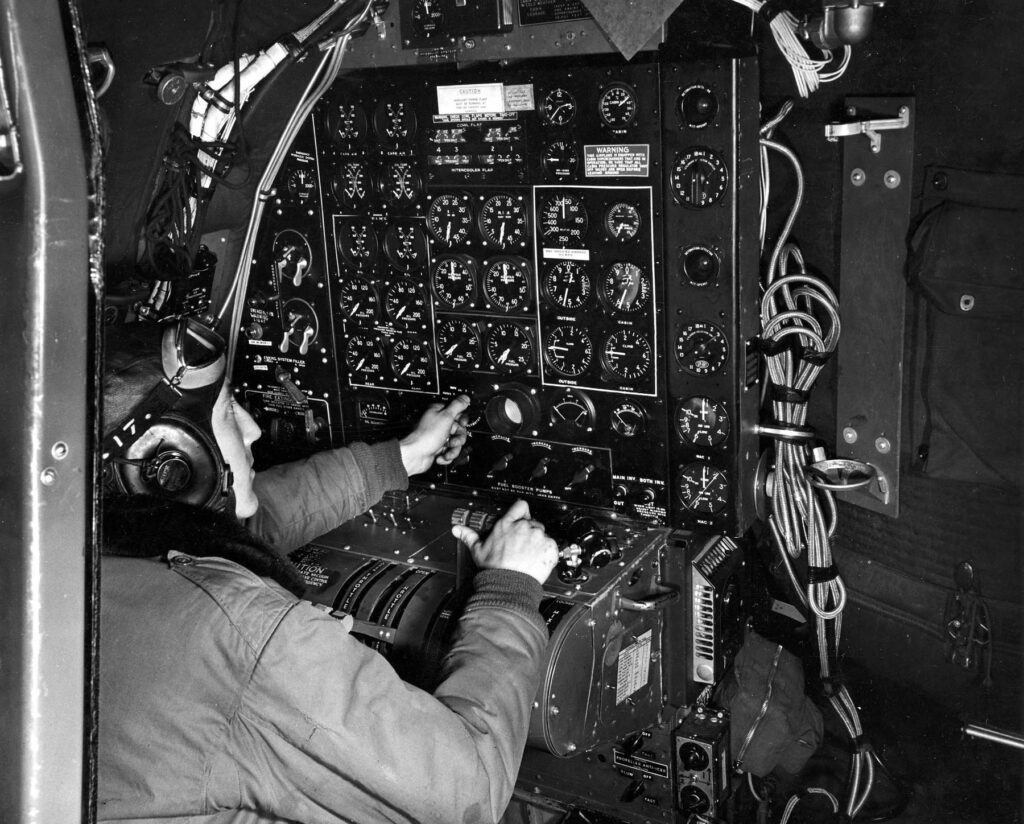
The flight engineer of a Boeing B-29, hard at work.
Note the object taking up the entirety of the right side – this is the pressurization tub for the bombers fore upper turret. These tubs are quite rare and the fore upper turret to B-29A 44-61975 has been removed so that visitors can better see inside. Said turret now sits beside the aircraft.
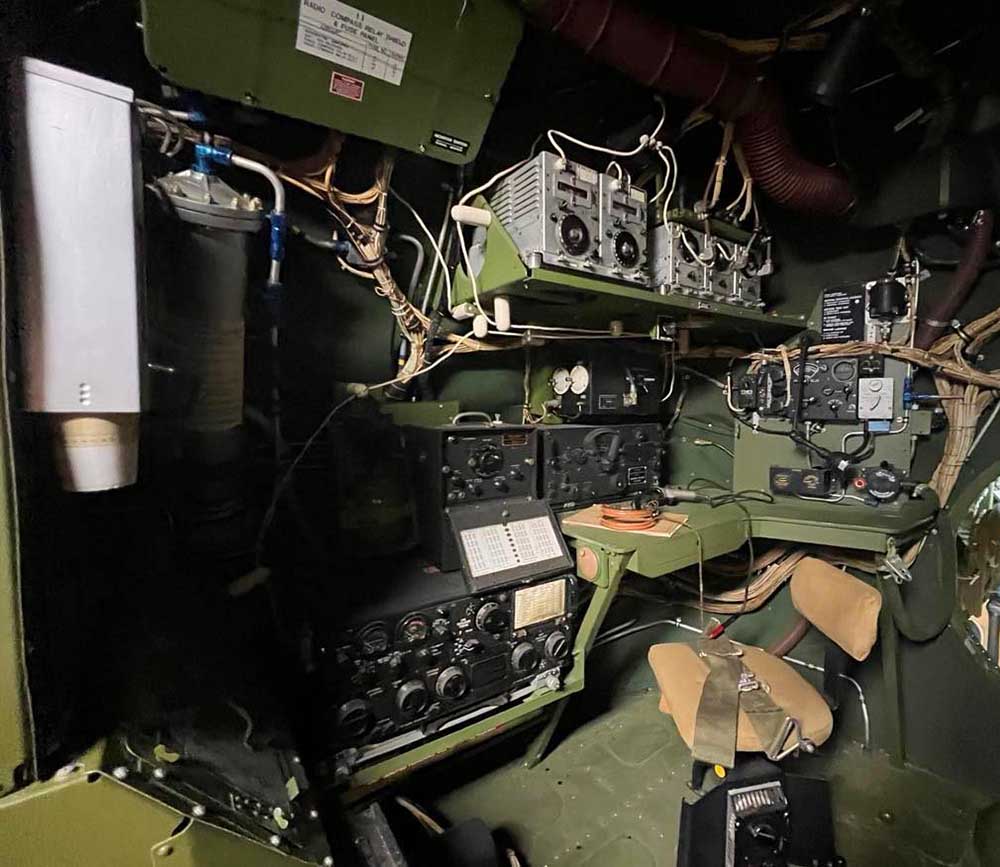
The radio operator’s position aboard Boeing B-29A 44-61975.
The infamous paper cup dispenser is on the left. If anyone has one of these, please let us know!
The forward upper turret’s innards have been removed to allow for better visibility. The turret itself sits outside next to the aircraft.
Photo taken 28 March 2023.

A Boeing B-29 radio operator at his position.
Note that the forward turrets have been removed from this aircraft, allowing a clear view of the radio operator’s position.
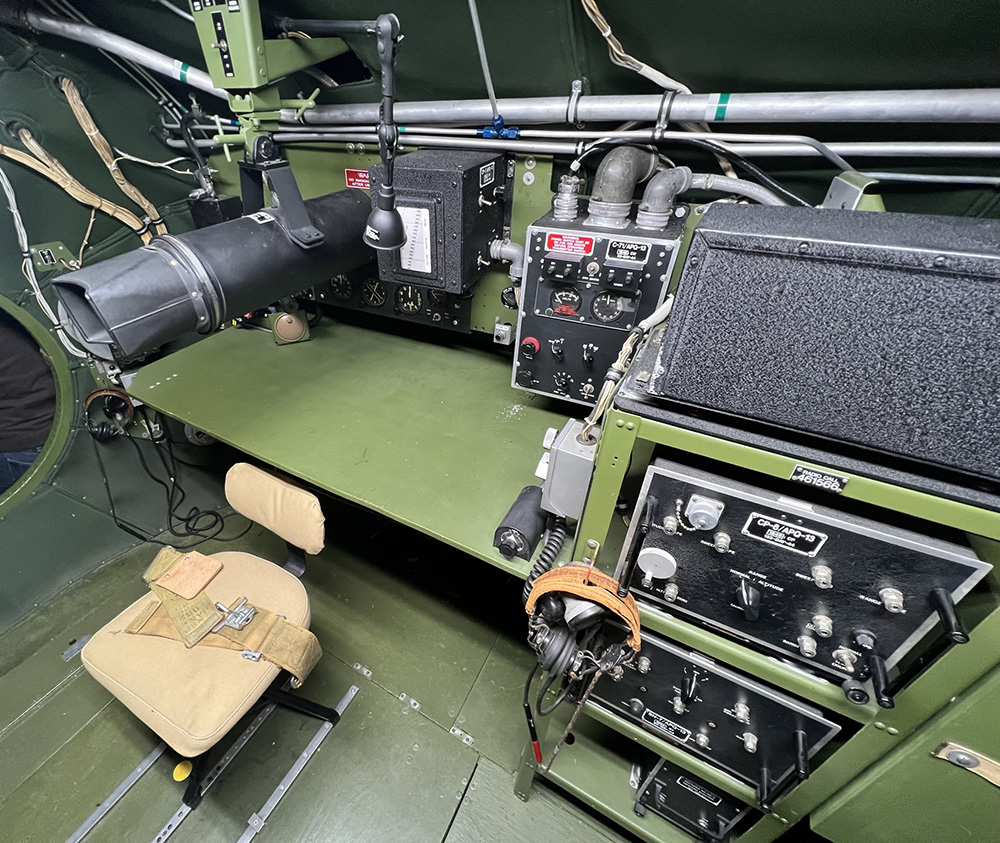
Crawling into the rear entry hatch (we did not crawl through the tube) takes you into windowless radar operator’s compartment.
Photo taken 28 March 2023.

The radar operator aboard a Boeing B-29 works while aerial gunners look on.
Note the pressurization tub for the aft upper turret in the upper right corner.
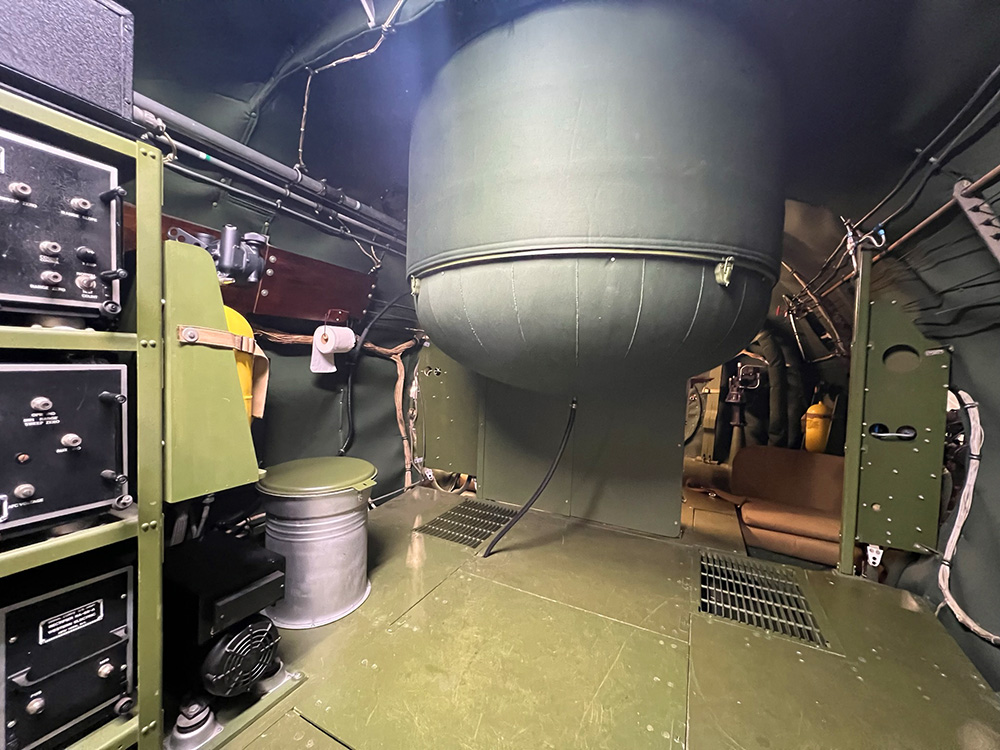
Looking forward from the radar operator’s position aboard Boeing B-29A 44-61975, you can see the bomber’s aft upper turret.
This is one of the tiny few surviving examples of a B-29 turret with its pressurization tub still intact.
Note the chemical toilet to the left. A rare piece, we are still on the lookout for one for Lucky Thirteen.
Photo taken 28 March 2023.
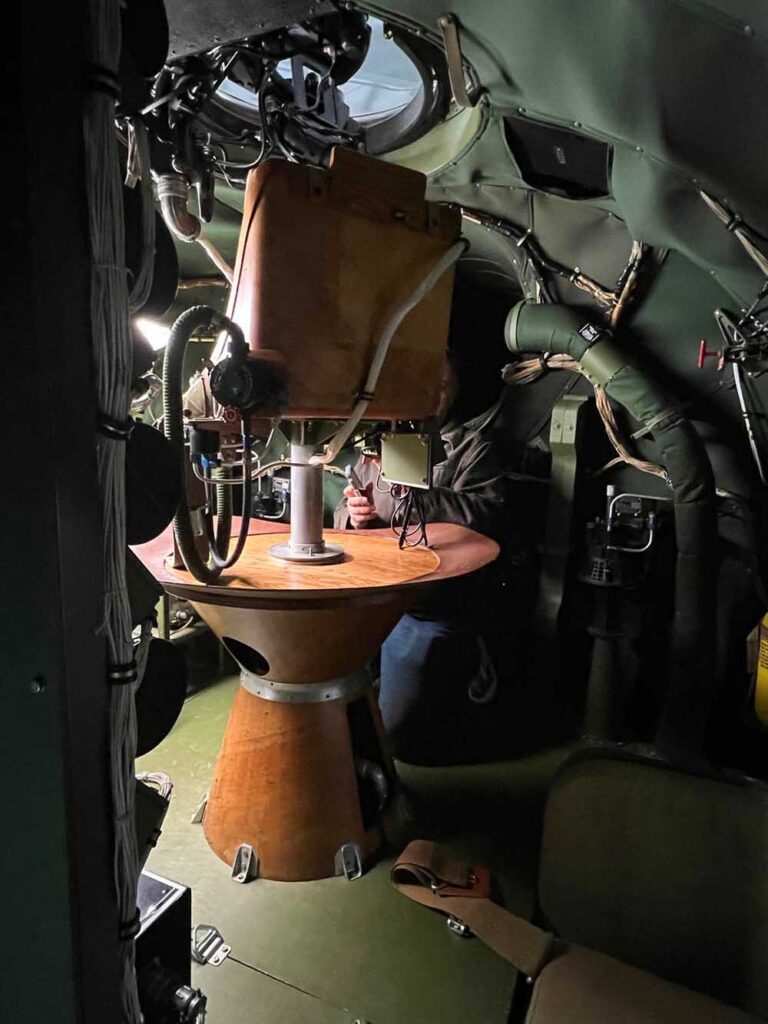
Peering forward from the radar operator’s compartment into the gunners’ compartment.
The B-29 used a “Central Fire Control” system, which used an analog computer system to assign turrets to various sighting stations aboard the aircraft.
Photo taken 28 March 2023.
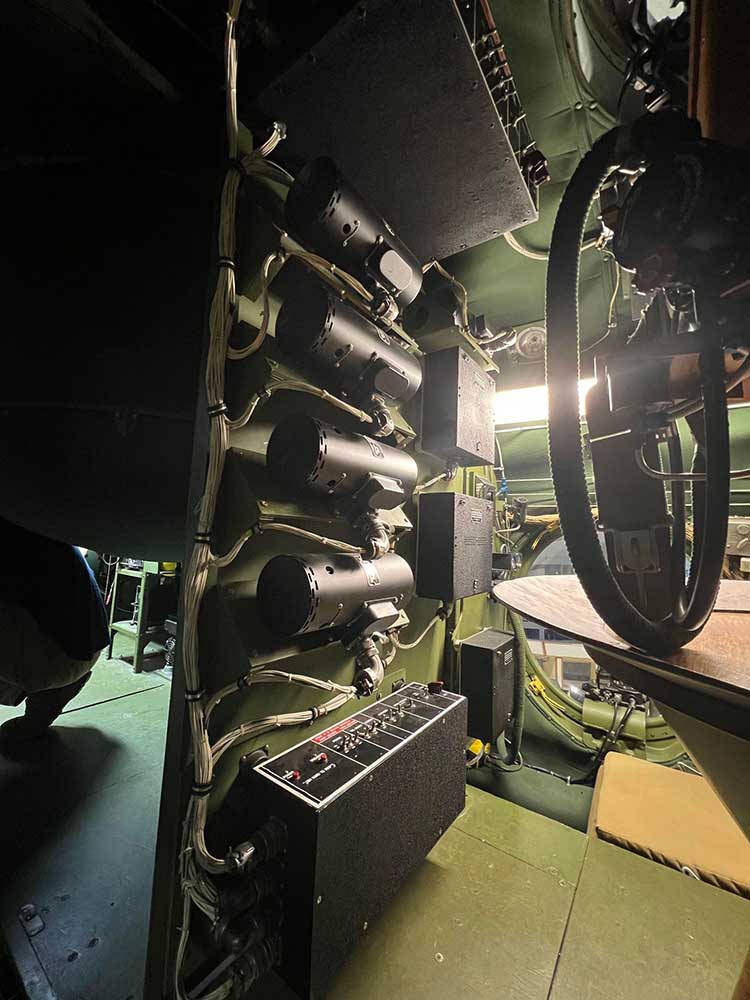
The electric motors for the Central Fire Control system aboard Boeing B-29A 44-61975.
The electric motors here power the various turrets and the box-like pieces are the system’s computers.
Photo taken 28 March 2023.
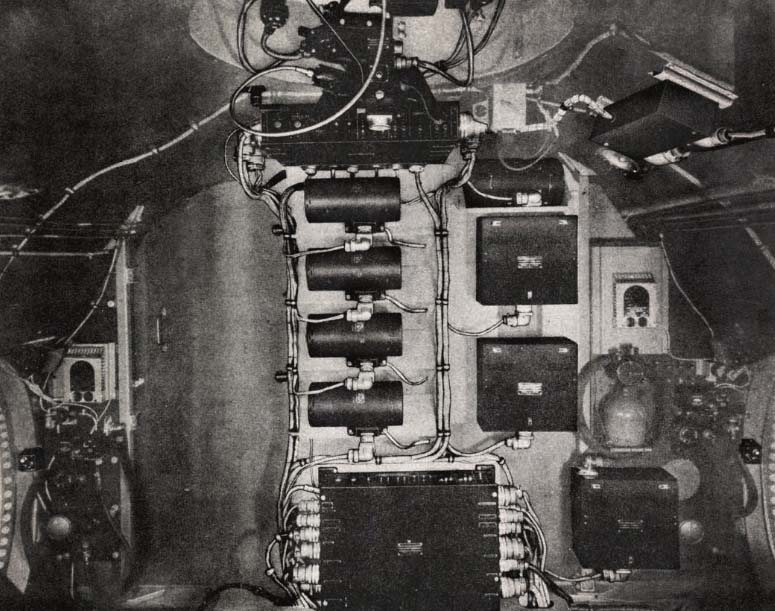
Manual illustration showing the gunner’s compartment of a Boeing B-29.
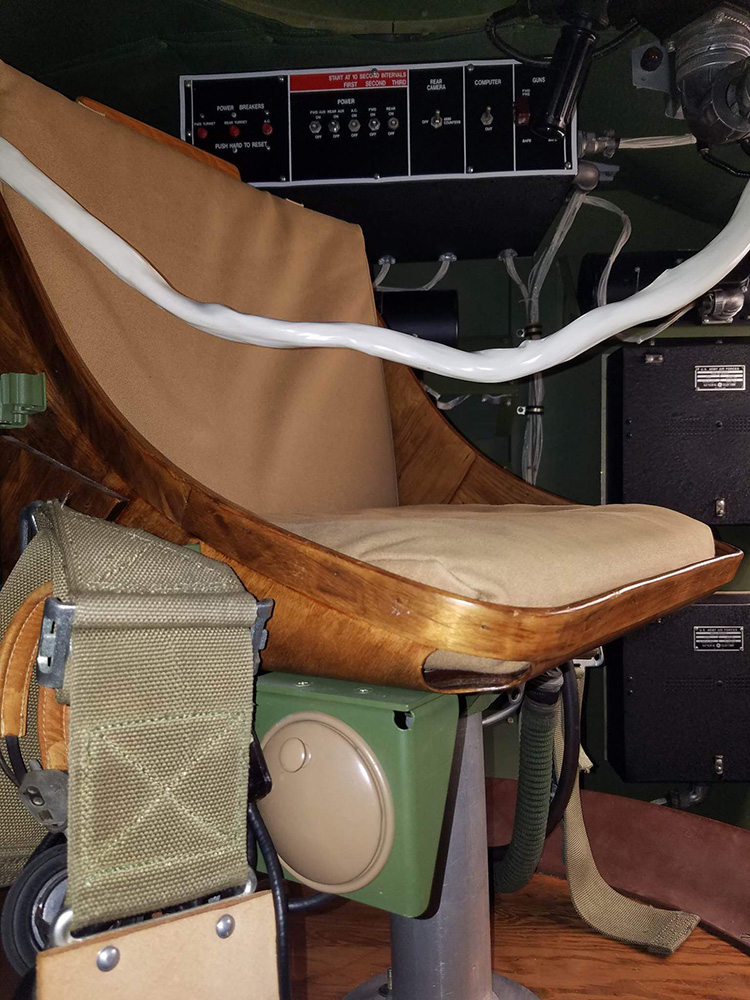
The upper gunnery position aboard Boeing B-29A 44-61975. Made of pressed plywood, this seat was known as the ‘barber chair.’
Photo taken 28 March 2023.

An airman in the upper gunnery position of a Boeing B-29.
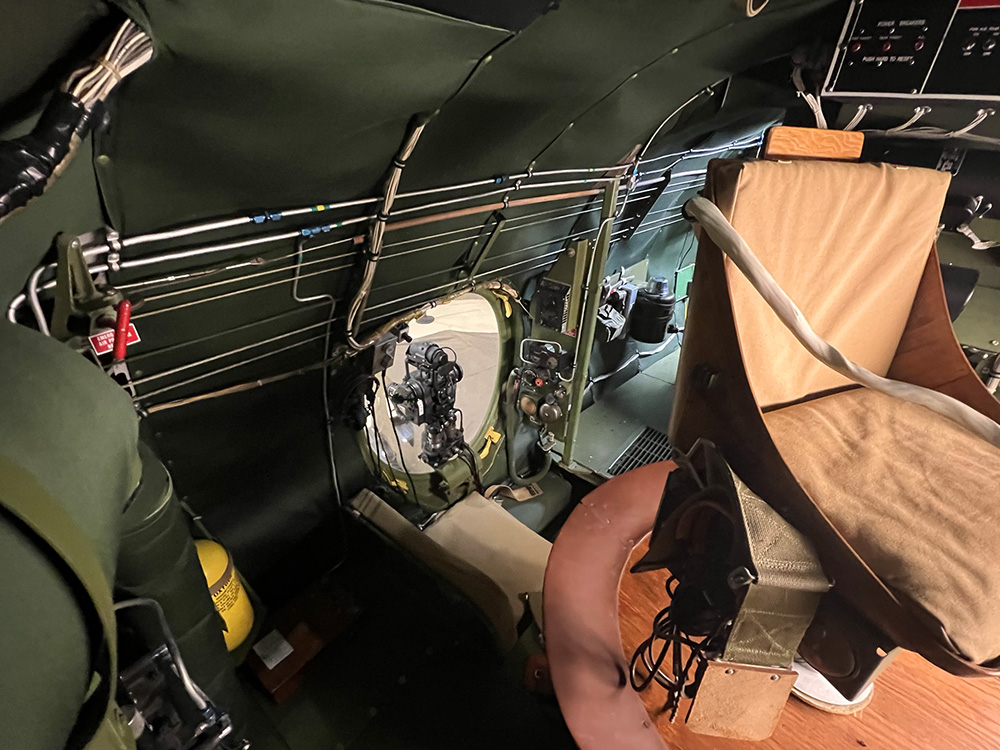
Looking aft from the crawl tunnel – which connected the forward compartment to the rear compartment over the bomb bay – toward the right waist gunner aboard Boeing B-29A 44-61975.
With the exception of the tail gun assembly, each of the four sighting stations had control over a primary and secondary turret, the computer assigning the turrets’ control as needed.
Photo taken 28 March 2023.

A Women’s Army Corps serviceman sits in the right waist position of a Boeing B-29.
Note the walkaround oxygen bottle on the back of the seat, should the aircraft lose pressurization. This is the same type of walkaround bottle that was used on Lucky Thirteen.

Looking aft from the crawl tunnel – which connected the forward compartment to the rear compartment over the bomb bay – toward the left waist gunner aboard Boeing B-29A 44-61975.
With the exception of the tail gun assembly, each of the four sighting stations had control over a primary and secondary turret, the computer assigning the turrets’ control as needed.
Photo taken 28 March 2023.
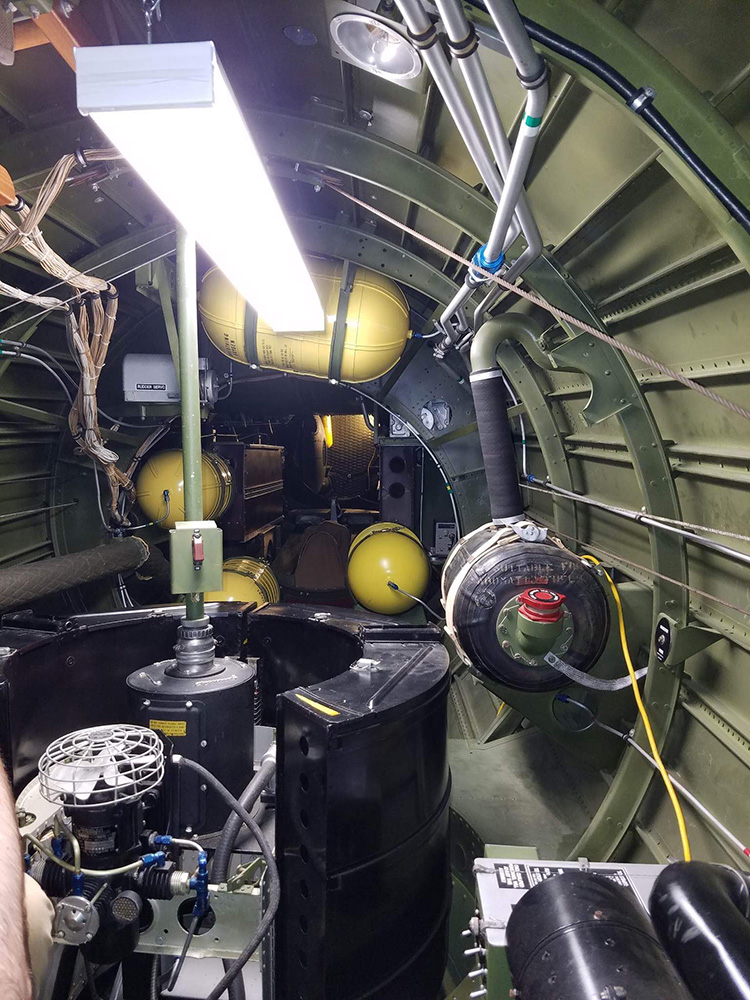
The unpressurized section of Boeing B-29A 44-61975 – the area between the radar operator’s compartment and the tail gunner’s compartment.
The aft lower turret is visible here as is the bomber Auxiliary Power Unit.
We did not crawl back into the tail gunner’s compartment.
Photo taken 28 March 2023.
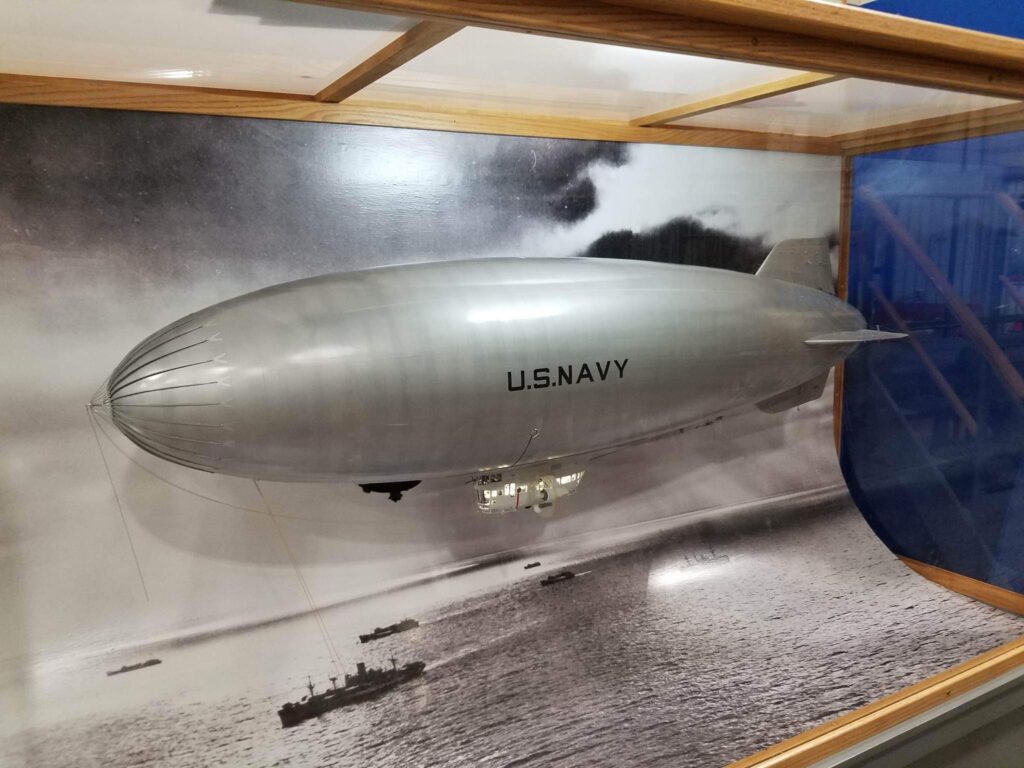
A model of K-28 while in service.
Photo taken 28 March 2023.

The forward section of K-28’s control gondola.
Note the ladder which allowed access to the blimp’s single M2 .50 caliber machine gun.
A single K-series blimp, K-74, was shot down during the war, being downed by U-134 off the coast of Florida on 18 July 1943.
Photo taken 28 March 2023.
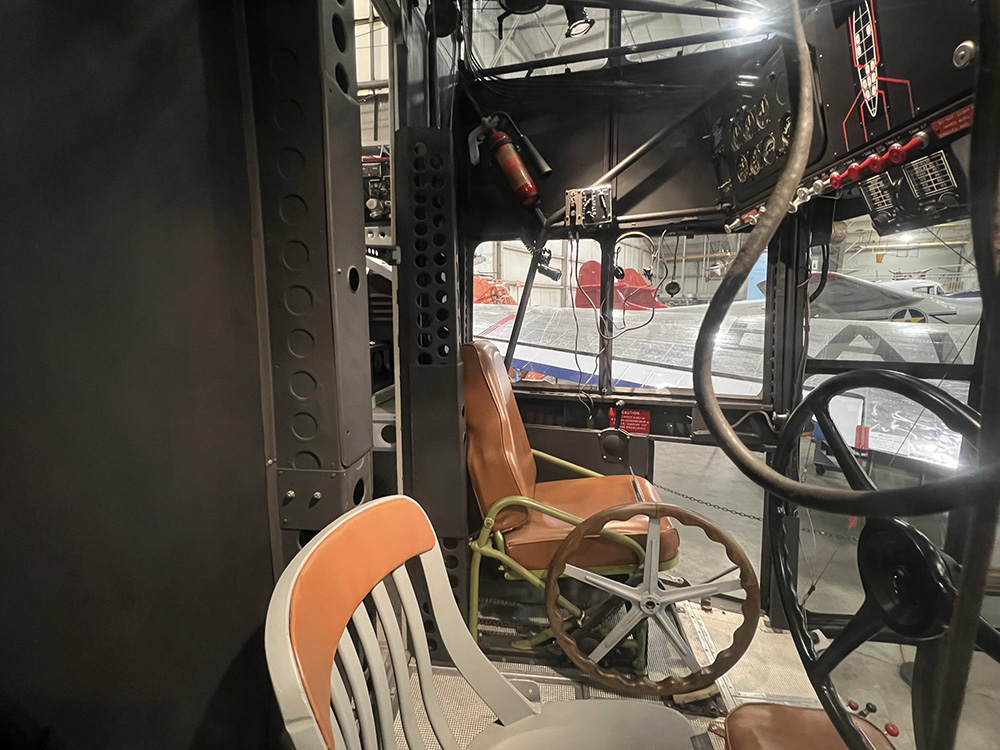
The pilot’s position aboard K-28. The bombardier’s seat is located on the floor between the two seats.
K-series blimps could carry four 350 lb depth charges.
Photo taken 28 March 2023.
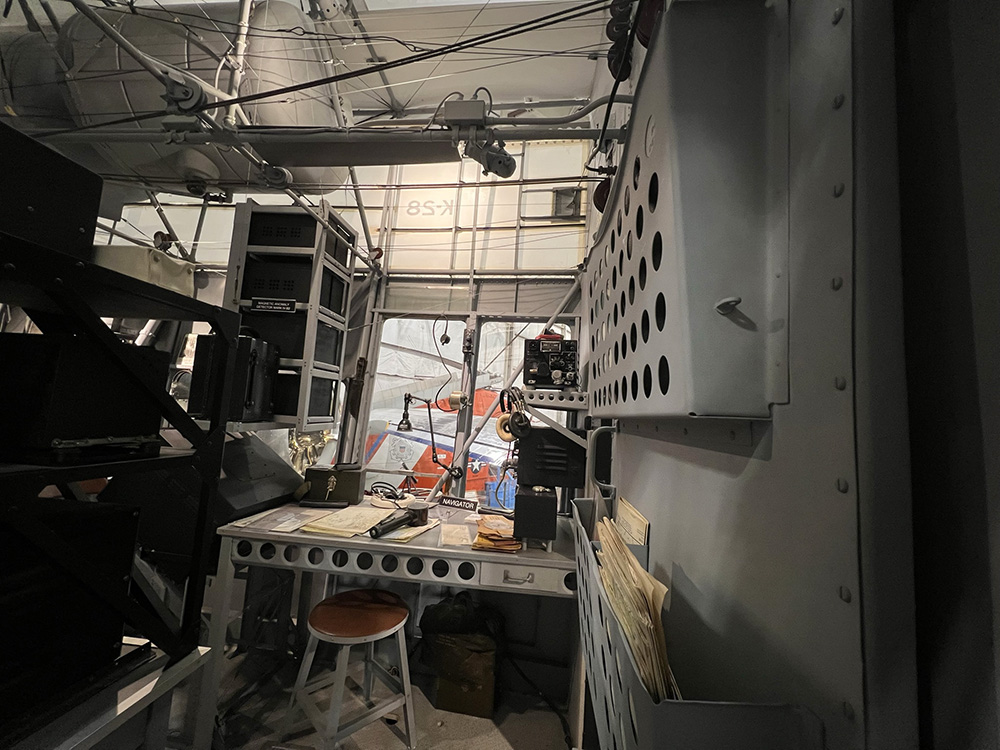
The navigator’s position aboard K-28.
Photo taken 28 March 2023.
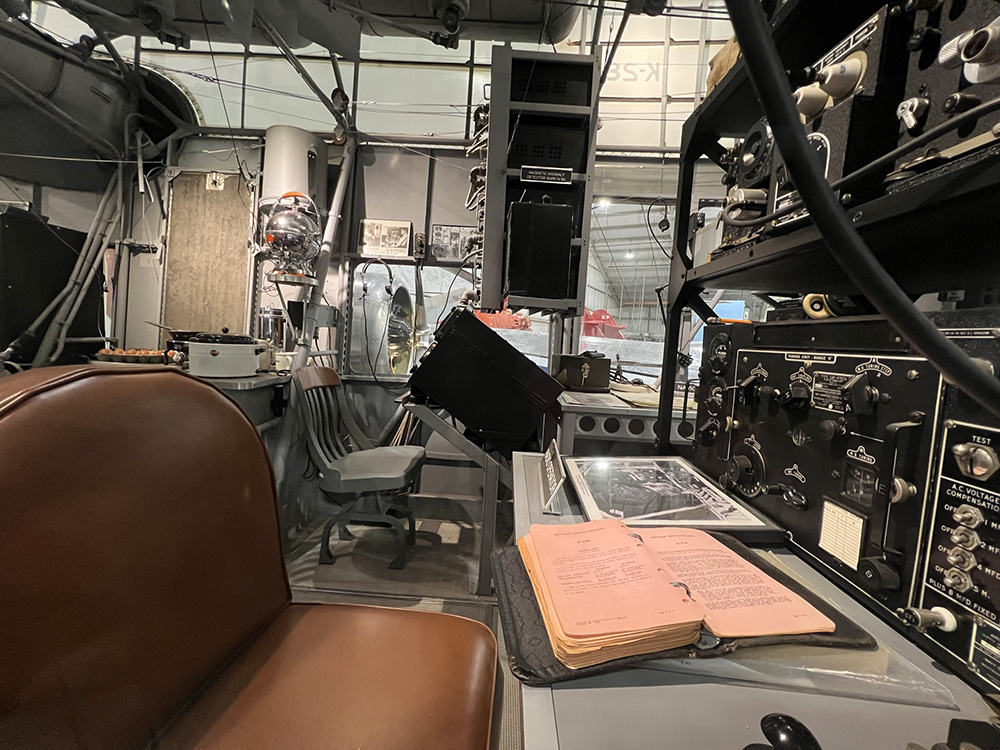
The radio and SONAR operator’s stations aboard K-28.
Photo taken 28 March 2023.

The radio and SONAR operator’s stations aboard K-28.
Note the galley behind the sonar operator.
Photo taken 28 March 2023.
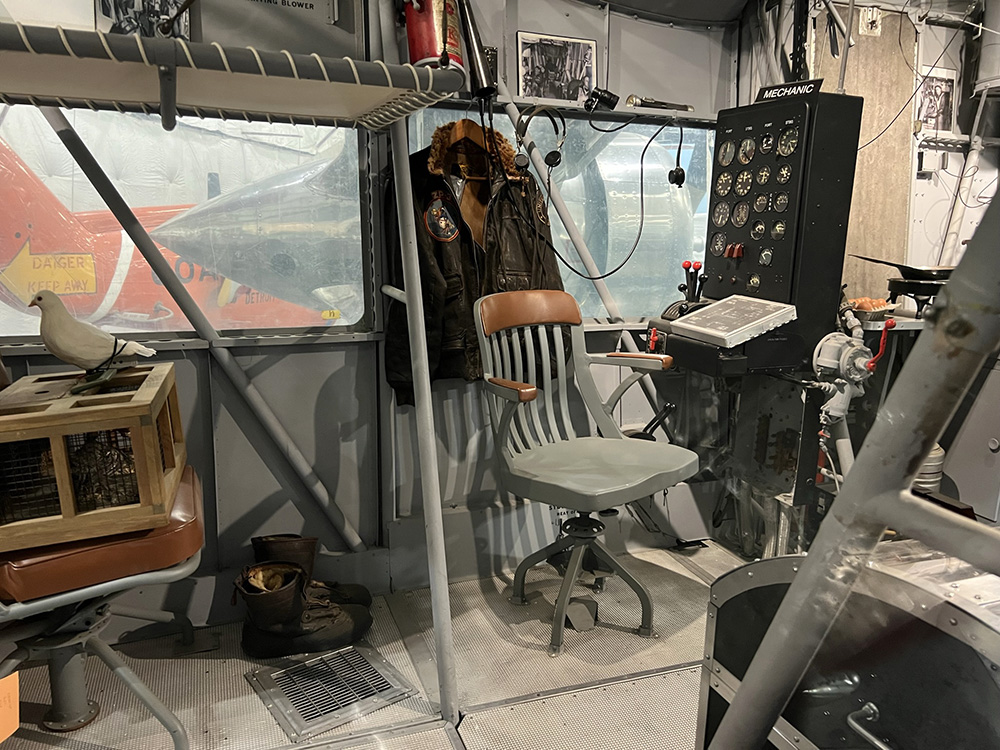
The flight engineer’s position aboard K-28, just aft of the galley.
Photo taken 28 March 2023.
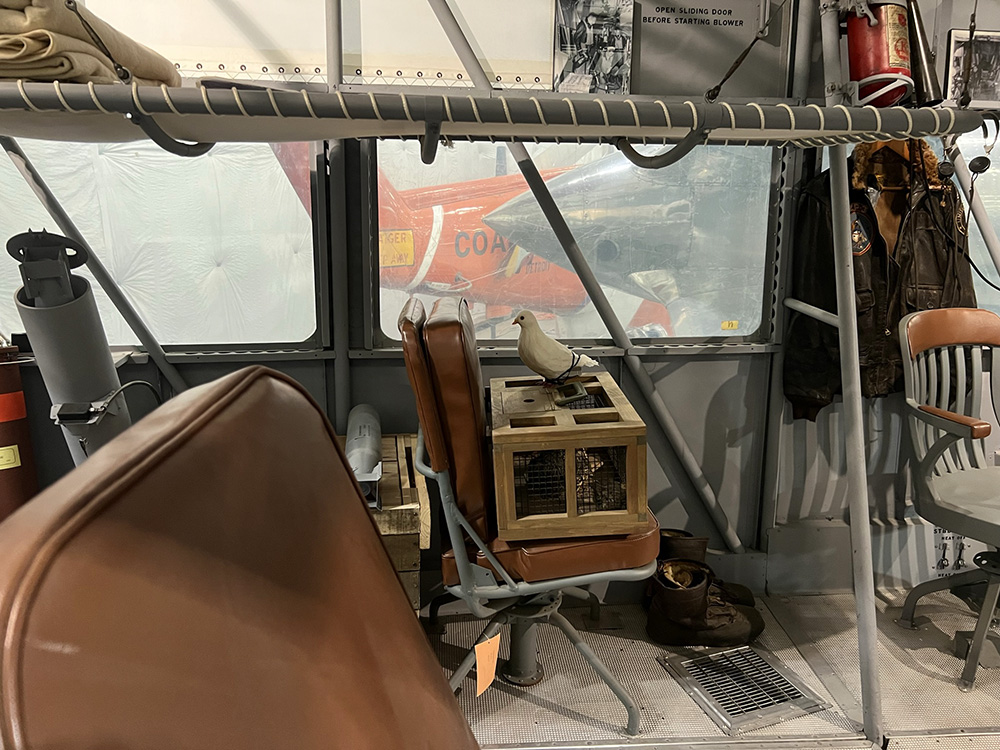
Observer positions board K-28.
Photo taken 28 March 2023.
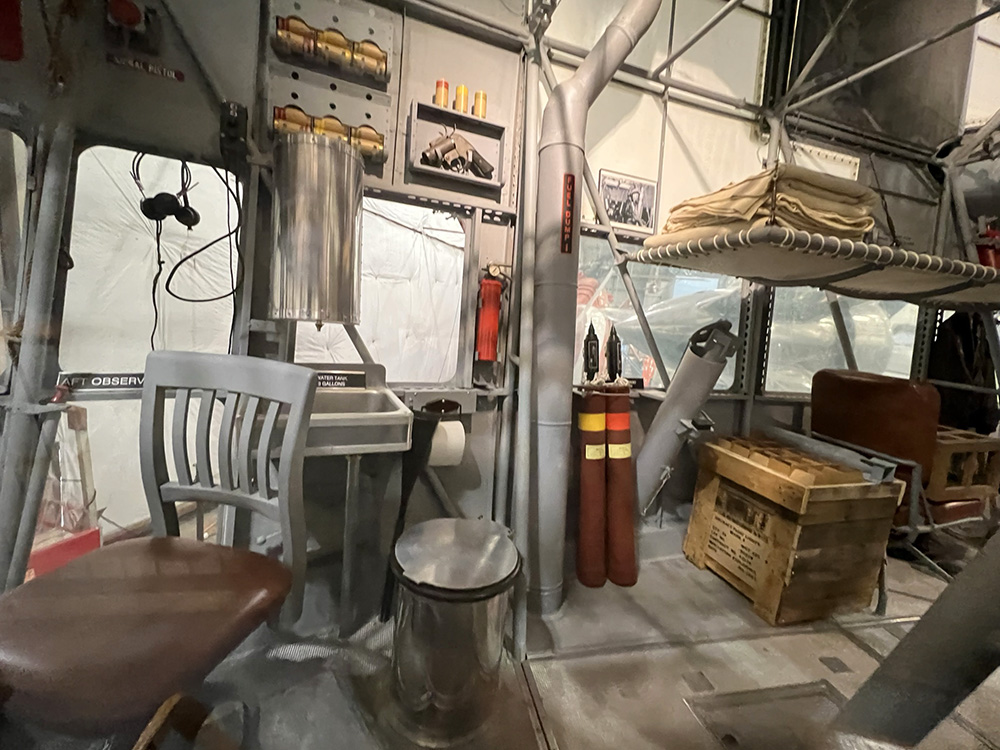
The photographer’s position aboard K-28.
Note the chemical toilet and sink. The sink is surprising as water is heavy and kept to a minimum on most lighter-than-air aircraft.
Photo taken 28 March 2023.

The fuse panel from one of Goodyear’s advertising balloons.
Photo taken 28 March 2023.

The Burnelli CBY-3 in flight.
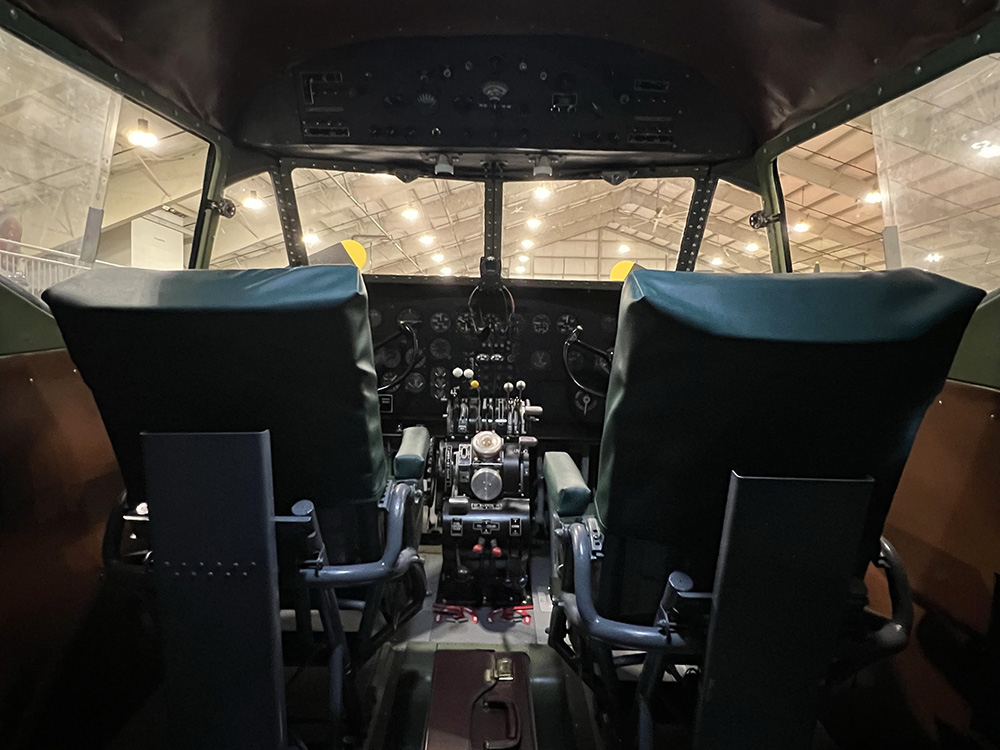
The beautifully restored cockpit of the Burnelli CBY-3.
Photo taken 28 March 2023.
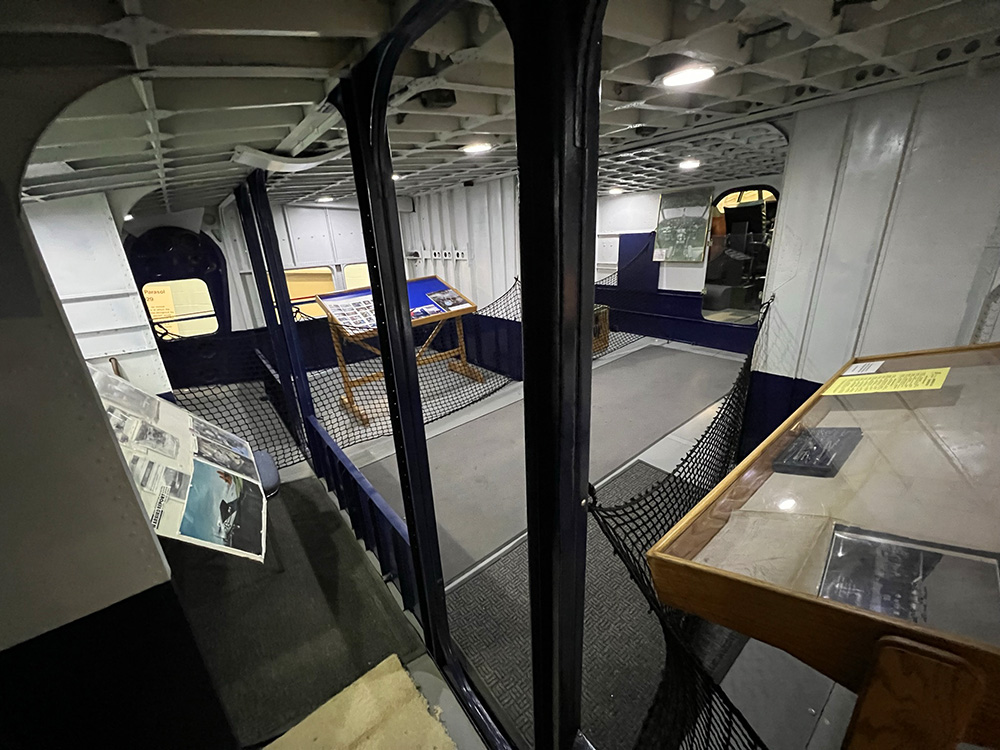
The spacious cargo bay of the Burnelli CBY-3.
Supposedly, this aircraft could carry a pair of Willis Jeeps without any trouble.
Photo taken 28 March 2023.
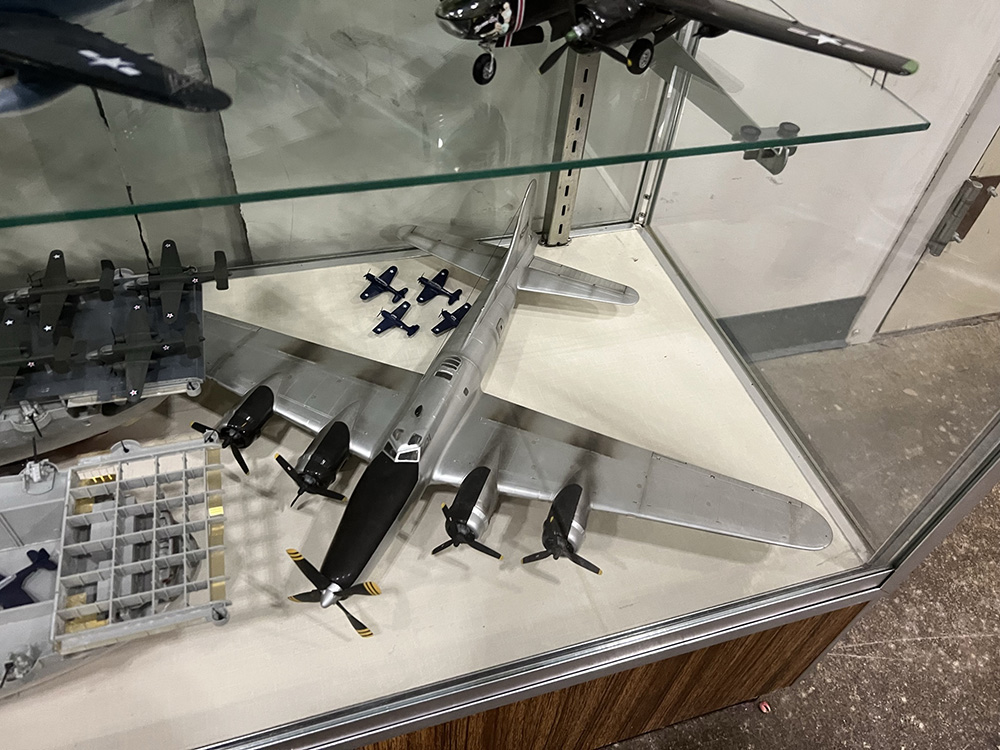
Gee, that airplane looks familiar…
Photo taken 28 March 2023.
